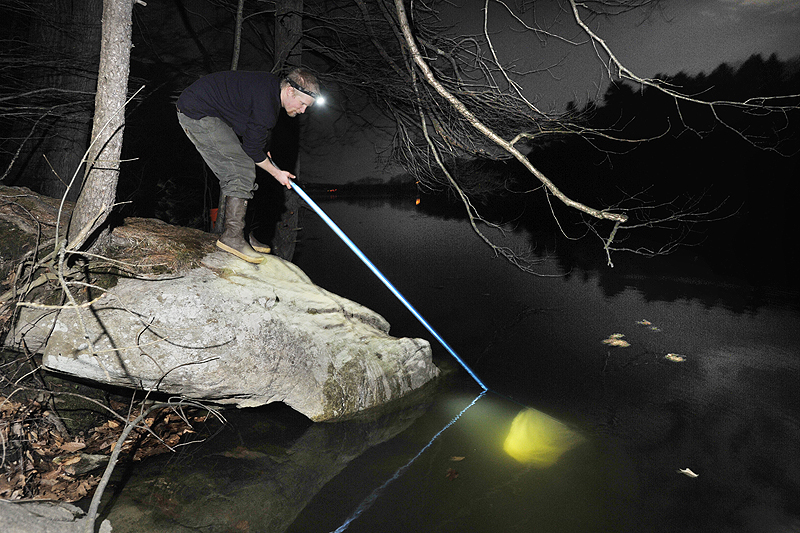At just after midnight early Thursday from a bridge over the Presumpscot River in Falmouth, the shoreline seemed to be strung with the soft, cold light of fireflies or the flickering flames of candles, magical in the half-dark, lit by a full moon.
But those lights were actually evidence of men at work. Each marked a spot where an elver fisherman was dip-netting for the baby eels that constitute one of the most valuable — and violated — fisheries going right now: elvers.
Competition for elvers is fierce, and so far the season has already produced a flurry of new developments, from the largest illegal-possession case on record and an unusual strain in relations between the state and the Passamaquoddy Tribe over licensing. Even the licensed fishermen have weighed in, with 50 last month forming the first Maine advocacy association for the fishery.
Ticketed violations are down compared with the same period last year — a fact that might seem surprising, given the fascination with the fishery and battles over licensing. From March 1 to April 19, 2012, 158 summonses were handed out by Maine Marine Patrol officers. During the same period this year, that number dropped to 103.
The reduction is probably the result of a number of factors, said Jeff Nichols, a spokesman for the Maine Department of Marine Resources. Greater public and media interest, along with strict enforcement and now criminal penalties, have also likely left some poachers more wary of being noticed. And the elver season in some coastal areas has been slower to start this spring, he said.
The intense interest in the fishery this year is occurring simultaneously with the rising tide of federal attention. The Atlantic States Marine Fisheries Commission, which has management jurisdiction over most fisheries in waters shared by states, is gathering public comments in New England and along the East Coast on proposed changes to the Interstate Fishery Management Plan for American eel. A meeting is set for 1 to 5 p.m. Tuesday at the Augusta Armory.
Elvers — by Maine law, American eels less than 6 inches long — have waxed and waned in value among the state’s fisheries, ranging from the low wholesale price of about $25 a pound just 10 years ago to last year’s all-time high of $2,000. Last week they were commanding a wholesale price of between $1,500 and $1,800 from Portland-area dealers.
The fishery also has demanded stricter enforcement from marine patrol officers, who track licenses, possession of the eels, and the method and sites of fishing. They have been a more visible presence among fishermen this season, said Nichols.
The 2013 elver season overall has been tumultuous, marred by poachers and riddled with conflicts over licensing. The Department of Marine Resources and the Passamaquoddy Nation locked horns early on, because the tribe has reserved its sovereignty over licensing tribal members, issuing nearly three times as many licenses as the state allocated to the tribe. The DMR in turn has reasserted its authority in enforcement, refusing to recognize as valid or legal any license numbers higher than the state total.
ENFORCEMENT GETS TOUGHER
That’s made the elver season more demanding for marine patrol Officer Tom Hale of Portland, who helps monitor sites in Cumberland County. He scours river banks, stream beds and even culverts for people violating state law by trying to harvest elvers without valid licenses. Shortly after dark last Wednesday night, Hale began a tour of areas in and around Portland that are favored for dip netting.
From his patrol truck, outfitted with a computer, he stayed in touch with his fellow officers by cellphone, exchanging information about particular sites that tend to be popular. He spends plenty of time on foot, too, combing the woods and carrying out one big part of his job: sneaking up on people and, he acknowledged, sometimes scaring them half to death with the surprise of having a law enforcement officer emerge from the trees.
It’s just one technique that Hale and other officers use to flush out offenders at night. They also check license plates on cars clustered near bridges or dams at access points where salt and fresh water mix, peer into culverts, keep an eye on white panel trucks that might host illegal dealers and, in general, watch for telltale signs of fishing: thick rubber gloves left behind, stuck into a rock pile along a shore; a piece of PVC pipe with a butterfly net attached to one end; and even littler evidence — bottles, cans and food wrappers.
The marine patrol covers the ground and the water, safeguarding all of the state’s fisheries and trying to take poachers out of the equation. Theirs is hard — but, Hale admitted, fun — enforcement work, often involving encounters with people under the cover of darkness. It helps to have a knack for keeping things nonconfrontational.
Occasionally, officers uncover illegal fishing and issue summonses for violations, which, as of last week, carry heavier penalties than ever before. The Legislature approved an emergency measure that made illegal possession and sale of elvers criminal, rather than civil, offenses, with mandatory fines of $2,000, discretionary seizure of gear and the potential for jail time for repeat offenders.
The tougher penalties extend to illegal purchases of elvers by dealers, too. Once largely a cash transaction, the sales of elver, under state law, now requires dealers to handle all business by check and to confirm legal sales and identities of harvesters through licenses and photo identifications.
TAKING RISKS FOR BIG MONEY
According to the Department of Marine Resources, the elver fishery is the state’s second-largest, behind lobsters, which account for 65 percent of Maine’s fishery sales. In 2012, more than 19,000 pounds of the tiny eels were harvested, bringing in nearly $38 million. That’s roughly a 10th of the value of lobsters, but still a lot of money. At the stage of growth the young migrating eels have achieved by the time they become a precious commodity, it takes 3,000 to 4,000 to produce a pound.
These young American eels are sought mainly for export to hatcheries in Asia and Europe, where overfishing, habitat loss, disease, natural disasters and industrial accidents have decimated the fishery. They have become so valuable, in fact, that poaching of the resource has been compared by some state legislators to the dangers of panning during the 19th century Gold Rush in California, and the black market of 1920s bootleggers during the rum-running era of Prohibition.
It’s not entirely an exaggeration. Already this year in Maine, tighter enforcement of the elver fishery has resulted in the largest seizure of illegally possessed elvers on record. Just two weeks into the season — which runs from March 22 through May 31 — marine patrol officers seized 41 pounds of elvers, valued at $80,000 to $100,000, from a New Hampshire man who was allegedly intending to sell the eels in Maine without a license, officials reported.
In mid-April, a Rockland man was charged with illegal possession of more than $20,000 worth of the eels. An investigation by marine patrol officers led to apprehension of the suspect near the Kennebunk exit of Interstate 95.
In Falmouth early Thursday, Hale issued summonses to five people on the Presumpscot; all identified themselves as Passamaquoddy Indians with tribal permits. But their licenses were not valid under state law, Hale said, and all face $2,000 fines if found guilty in District Court.
In contrast, most legally licensed elver fishermen can net $600 to $1,400 for five days’ work, even in slow periods of the season. Elver fishing is prohibited by law for 24 hours starting at noon on Tuesdays and Saturdays, a break specifically designed to give the eels a fighting chance.
That is exactly what the Atlantic States Marine Fisheries Commission is trying to accomplish, too, with a proposal that includes a range of management options to reduce the decline in eel populations. Marine biologists believe the decline might be cyclic, but is aggravated in the western Atlantic by overfishing, lost habitat, changes in the ocean food web and increased predation. Eel deaths historically have been linked to turbines and dams, and more recently to environmental changes, including warmer water temperatures and acidification, toxins, contaminants and disease, according to the commission.
Increased management could entail greater state responsibility for monitoring and policing the fishery — tasks already putting a burden on marine fisheries personnel. And the commission could opt to place greater restrictions on license limits or even shut down the fishery until stocks rebound.
But, for now, the eel — at every stage of its life cycle — is desired for harvest. It is considered a delicacy in its immature state, and in much of Europe — where parasites and ocean changes have afflicted the fishery for more than 30 years — as well as in China and Japan, the American eel represents hope of recovery for fisheries in decline.
A PRETTY PROFITABLE LIVELIHOOD
For Mainers, it represents a livelihood that is hard to resist, whether licensed or illegal.
“We’re the only game in town; that drove the price up,” Hale explained. And the economy is bad, he acknowledged, admitting to a degree of empathy for people tempted to cross the line into prohibited fishing. “Everybody,” he said, “needs money.”
For lobsterman Henry McVane, 21, of Portland, who got one of the 50 new elver licenses through a lottery, this fishery opens up a chance to earn good pay, working for himself during what is an off-season for other fisheries.
The money is very good — a definite draw that will induce him to renew his license again next year, he said. (Licenses renew automatically if fishermen reapply.)
The season — and fishermen’s moods — improve as the weather warms, making the tedious hours and hours of dip-netting from rocks and shoreline in the dead of night more tolerable.
“It’s just getting good now for me,” McVane said, stopping last week in Falmouth on the warmest night of the season so far to talk about his newly acquired fishing skills and catch. “It’s very interesting,” he said of elver fishing. “Lobstering is a lot harder; there’s a lot more gear involved.”
But the main lure, he admitted, is the fishery’s profitability.
“Making $600 to $1,400 a week — you can’t do that anywhere else right now,” he said. That’s especially attractive, particularly considering that the upfront costs run to about $300 to $400 for dip netters, and perhaps $2,000 to $2,500 for those using the large, draped fyke nets that can capture exponentially more elvers.
Beyond the license costs, McVane invested a few hundred dollars on poles, netting, a lantern, waders, a head lamp and the other few essentials needed for dip netting. He tries different spots, sometimes 20 miles away from a river he fished the night before. As in all fishing, results vary dramatically from day to day, river to stream. One recent evening, he captured a quarter pound; the next, 1¼ pounds. That’s potentially more than $2,000 for two nights’ work.
“I’ve never really worked a 9 to 5 job,” said McVane, who’s found elver fishing a good fit. “You work hard and get paid. It’s real nice … calm, the moon (is) out. … Everyone I talk to is friendly.”
North Cairn can be contacted at 791-6325 or at:
ncairn@mainetoday.com
Send questions/comments to the editors.




